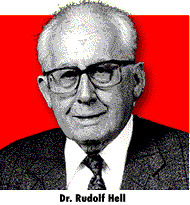

Dr. Ing Rudolf Hell was born on 19 December 1901 in the Bavarian town of Eggemuehl. When Rudolf was six years old, his father, a railway official, was relocated to Eger - a town which today forms part of the Czech Republic. As a schoolboy, Rudolf excelled in physics and maths, so it came as no surprise when he decided to study electronic engineering. In 1927, Hell earned himself the title of doctor of engineering for the paper he wrote describing his invention of an automatic direction finder for aerial navigation. The invention described by Hell allowed pilots to locate the direction of a transmitter, thus enabling them to reach their destinations safely even in the dark or fog.
Hell continued to experiment. His next invention was the image scanning tube used in televisions, and in 1929 he applied for a patent for a "device for the electric transmission of written characters". The "Hell recorder" (or "Hellschreiber"), as it was then known, worked by breaking down graphic information into thousands of tiny individual dots, which were then transmitted before being put back together again at the receiving end. The basic idea of today's fax machines had been born. And it was now possible to do away with interference-prone Morse telegraphy.
Nineteen twenty-nine was also the year in which Hell founded his own company in Berlin. The fact that he set up his company at this point in time, that is to say in a period of economic depression and amidst a climate of political turmoil, bears witness to the remarkable initiative and elan of this exceptional young man who was a mere 28 years old at the time. Starting out with only a very small staff, Hell pushed ahead with the "Hell recorder" he had invented. He later became involved with radio direction finders and radio compasses, and during World War II, even with encoders and acoustic mine exploders. Towards the end of the war, Hell had some 1,000 employees working for him. By the time the war finally ended, however, the company premises in Berlin had been destroyed in an air-raid by the Allies and the firm had ceased to exist.
In 1947, Hell started up again, but this time in Kiel, repairing "Hell recorders". This was followed by his invention of the electronically controlled engraver - yet another revolutionary product to his name! The "Klischograph", as it was called, could convert contone and line images directly into "Klischees" (printing blocks) by means of electronic scanning and electromechanical engraving.
The outstanding success of this first "Klischograph" almost inevitably led to further inventions, ranging from Vario-Klischographs and Colorgraphs to the world-famous Chromagraphs. Other product lines which included the facsimile transmission of newspaper pages, fonts and photo typesetting devices also played a role in the rapid growth of the company.
Rudolf Hell is currently enjoying his retirement in Kiel following the company's merger with Linotype in 1990.
(With acknowledgements to Heidelberg, who have deleted this biblography from their site!)
Back